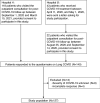Long COVID occurrence in COVID-19 survivors
- PMID: 35411017
- PMCID: PMC8996498
- DOI: 10.1038/s41598-022-10051-z
Long COVID occurrence in COVID-19 survivors
Abstract
This cross-sectional study aimed to investigate the post-acute consequences of COVID-19. We conducted a self-administered questionnaire survey on sequelae, psychological distress (K6), impairments in work performance (WFun), and COVID-19-related experiences of stigma and discrimination in two designated COVID-19 hospitals in Hiroshima Prefecture, Japan, between August 2020 and March 2021. The prevalence of sequelae was calculated by age and COVID-19 severity. Factors independently associated with sequelae or psychological distress were identified using logistic regression analysis. Among 127 patients who had recovered from COVID-19, 52.0% had persistent symptoms at a median of 29 days [IQR 23-128] after COVID-19 onset. Among patients with mild COVID-19, 49.5% had sequelae. The most frequent symptoms were olfactory disorders (15.0%), taste disorders (14.2%), and cough (14.2%). Multivariate analysis showed that age was an independent risk factor for sequelae (adjusted odds ratios [AOR] for ≥ 60 years vs. < 40 years 3.63, p = 0.0165). Possible psychological distress was noted in 30.7% (17.9% of males and 45.0% of females). Female sex and the presence of sequelae were independent risk factors for psychological distress. Of all participants, 29.1% had possible impairments in work performance. Experiences of stigma and discrimination were reported by 43.3% of participants. This study revealed the significant impacts of Long COVID on health in local communities. A large-scale, long-term cohort study is desired.
© 2022. The Author(s).
Conflict of interest statement
The authors declare no competing interests.
Figures





References
-
- Ministry of Health, Labour and Welfare, Japan. Discharge and other criteria for patients with new coronavirus infection (variants) [in Japanese]. https://www.mhlw.go.jp/content/000776018.pdf (2021).
-
- The Lancet. Facing up to long COVID. The Lancet396, 1. 10.1016/s0140-6736(20)32662-3 (2020).
-
- National Institute for Health and Care Excellence. COVID-19 rapid guideline: managing the long-term effects of COVID-19. https://www.nice.org.uk/guidance/ng188 (2020). - PubMed
Publication types
MeSH terms
LinkOut - more resources
Full Text Sources
Medical

